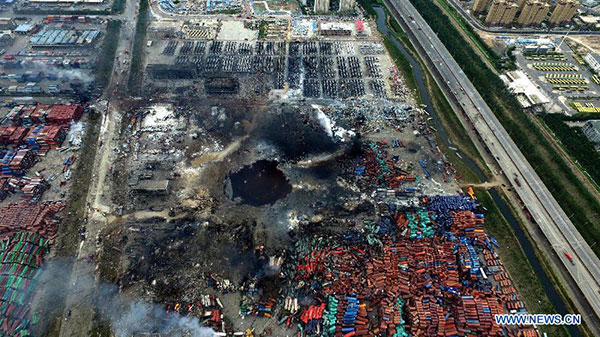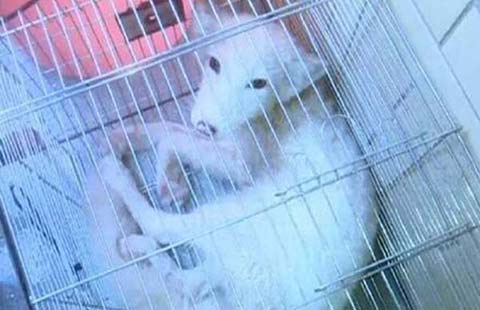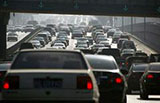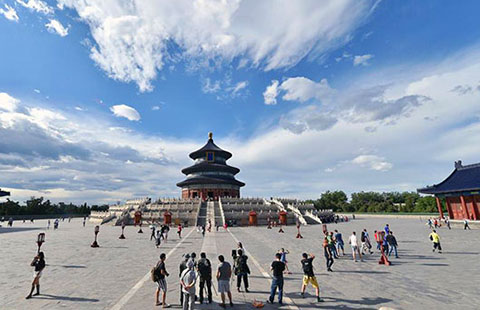Man rescued from Tianjin blasts site, under stable condition
(chinadaily.com.cn) Updated: 2015-08-15 20:36
|
 |
|
An aerial photo taken on Aug. 14, 2015 shows a huge hole at the core area of explosion site in Tianjin, North China. The death toll from explosions occurred on Wednesday night rises to 85 as of Saturday morning.[Photo/Xinhua] |
85 confirmed dead
Tianjin authorities said on Friday that they still don't know the detailed types and quantities of dangerous chemicals that were being stored in a warehouse that exploded in the port city on Wednesday night, killing at least 85 people.
Gao Huaiyou, deputy head of Tianjin's work safety watchdog, said that information about what was in the warehouse remains inconsistent.
He said that since the warehouse in the Tianjin Binhai New Area was for transitional storage, exact information is unavailable, especially after the offices of Ruihai Logistics Co, Ltd, which owned the warehouse, have been damaged. In addition, information provided by senior managers diverges from customs data, he said.
He noted that the warehouse that was holding dangerous chemicals was being redesigned from an ordinary storehouse, Gao said, with proper safety reviews and security checks by port authorities.
Zhou Tian, chief of firefighting at Tianjin's public security bureau, said at a news briefing on Friday that flames at the scene have been "basically extinguished" and are unlikely to reignite, and that sand is being used for chemical fires where water is inappropriate.
At least 44 people had been rescued from debris as of 6 pm on Friday, and at least 66 large pieces of rescue equipment and 600 metric tons of sand have been used.
However, the city's latest briefing on the tragedy failed to provide clues to its cause.
Officials also refrained from addressing public concerns on whether dangerous chemicals were stored too close to communities, or if improper firefighting methods had caused more explosions.
About 17,000 households, 1,700 companies and 675 stores have been affected by the blast.
The work safety committee of the State Council called on Friday for a nationwide blanket security check on the production, handling, storage and transportation of dangerous chemicals, flammable and explosive goods, especially those near communities, crowded areas and transportation hubs.
Feng Yinchang, an environmental expert from Nankai University, said air quality near the blast site remains normal and will not have a harmful effect on residents, though some of the monitoring stations detected toluene, chloroform, methylbenzene and volatile organic compounds-all hazardous pollutants.
"The concentrations were decreasing because of wind blowing toward the sea," Feng said.
Wang Lianqing, a senior engineer with the Tianjin Association of Environmental Protection Industry, said the sewers discharging into the sea were closed on Thursday morning and rainwater drainage pipes were closed in the afternoon.
"All contaminated water has been contained within a sewage plant, and the plant has adopted a biochemical treatment system to process the polluted water."
Zhang Ruigang, deputy head of Tianjin Binhai New Area, said more than 110 medical experts have been transferred from downtown to support local medical staff.
Pei Rongguo, 37, a migrant construction worker from Henan province, said he would return home to Henan once he's recovered.
Now settled in a school-turned-resettlement in the Tianjin Binhai New Area, Pei was in a dormitory next to an rail station that was severely damaged in the blasts.
"But I probably have to come back (to Tianjin). ... I have to support my family," said the father of two who was slightly injured in the left foot and back. "I was sleeping at that time and had no idea what had exploded. I can't think too much now. ... It is good enough to survive," he said.
Related stories:
Harmful pollutants found near Tianjin site; outlets blocked
- Delegation salutes Tibet anniversary
- Officials are told to act as anti-graft watchdogs
- Great Wall safeguarded in united action
- Vice minister pledges more efforts to improve air quality
- Beijing’s efforts to control air pollution start to pay off
- China's military committed to reform
- Netizens rip singer over baby photos
- Central govt's growing support for Tibet
- Monument to be built on Tianjin blast site
- China and Russia seal raft of energy deals







